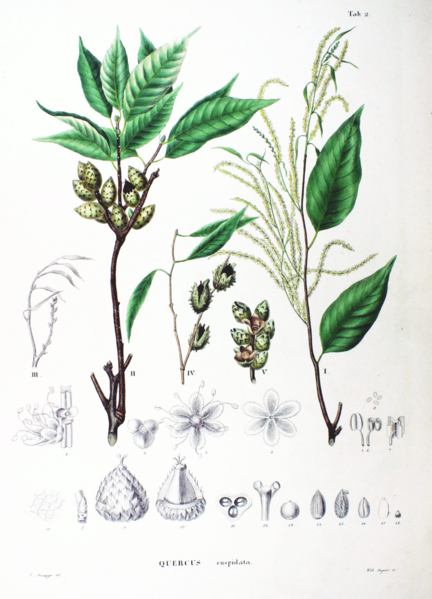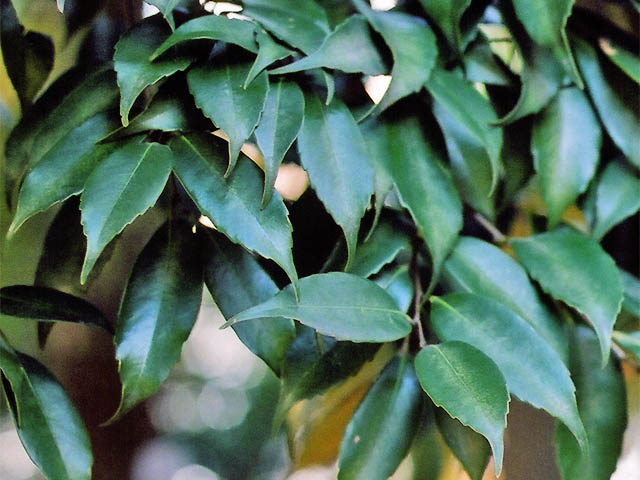 |
|
http://commons.wikimedia.org/wiki/File:Castanopsis_cuspidata_SZ2.png |
 |
| http://commons.wikimedia.org/wiki/User:Inti-sol |
Translate this page:
Summary
Physical Characteristics

 Castanopsis cuspidata is an evergreen Tree growing to 25 m (82ft) by 10 m (32ft).
Castanopsis cuspidata is an evergreen Tree growing to 25 m (82ft) by 10 m (32ft).
See above for USDA hardiness. It is hardy to UK zone 7. It is in leaf all year. The species is monoecious (individual flowers are either male or female, but both sexes can be found on the same plant) and is pollinated by Wind, midges.
Suitable for: medium (loamy) and heavy (clay) soils. Suitable pH: mildly acid and neutral soils. It can grow in semi-shade (light woodland). It prefers moist soil.
UK Hardiness Map
US Hardiness Map
Synonyms
Quercus cuspidata.
Plant Habitats
Woodland Garden Canopy;
Edible Uses
Edible Parts: Seed
Edible Uses:
Seed - cooked[2, 46, 63, 105, 177]. The cotyledon of the nut is eaten boiled or roasted[183].
References More on Edible Uses
Medicinal Uses
Plants For A Future can not take any responsibility for any adverse effects from the use of plants. Always seek advice from a professional before using a plant medicinally.
None known
References More on Medicinal Uses
The Bookshop: Edible Plant Books
Our Latest books on Perennial Plants For Food Forests and Permaculture Gardens in paperback or digital formats.

Edible Tropical Plants
Food Forest Plants for Hotter Conditions: 250+ Plants For Tropical Food Forests & Permaculture Gardens.
More

Edible Temperate Plants
Plants for Your Food Forest: 500 Plants for Temperate Food Forests & Permaculture Gardens.
More

More Books
PFAF have eight books available in paperback and digital formats. Browse the shop for more information.
Shop Now
Other Uses
References More on Other Uses
Cultivation details
Prefers a good deep medium to stiff loam[1]. Requires a sheltered position in semi-shade and a lime-free soil[138]. Although cold hardy in Britain, this species really requires a warm continental climate if it is to prosper and it does not do well in the maritime climate of this country[200]. It succeeds in the London area but does not attain its full size there[11]. It grows well in S.W. England[11]. The catkins have an unpleasant hawthorn-like smell to attract midges for their pollination[245].
References Carbon Farming Information and Carbon Sequestration Information
Temperature Converter
Type a value in the Celsius field to convert the value to Fahrenheit:
Fahrenheit:
The PFAF Bookshop
Plants For A Future have a number of books available in paperback and digital form. Book titles include Edible Plants, Edible Perennials, Edible Trees,Edible Shrubs, Woodland Gardening, and Temperate Food Forest Plants. Our new book is Food Forest Plants For Hotter Conditions (Tropical and Sub-Tropical).
Shop Now
Plant Propagation
Seed - requires a period of cold stratification and is best sown as soon as it is ripe in a cold frame[138]. The seed has a short viability and should not be allowed to dry out. It can be stored for a few months if kept cool and moist (putting it in a plastic bag that is placed in the salad compartment of a fridge works well). Stored seed should be soaked in warm water for 24 - 48 hours prior to sowing[138]. Germination usually takes place within 1 - 3 months at 15°c[138]. As soon as they are large enough to handle, prick out the seedlings into individual pots and plant them out in mid summer if possible, otherwise grow them on in a cold frame for their first winter and plant them out in late spring. Give the young plants some protection from cold for their first few winters outdoors.
Other Names
If available other names are mentioned here
Native Range
TEMPERATE ASIA: China (Fujian Sheng, Guangdong Sheng, Zhejiang Sheng), Japan (Honshu, Kyushu, Shikoku), Korea, South, Taiwan
Weed Potential
Right plant wrong place. We are currently updating this section.
Please note that a plant may be invasive in one area but may not in your area so it’s worth checking.
Conservation Status
IUCN Red List of Threatened Plants Status :

Growth: S = slow M = medium F = fast. Soil: L = light (sandy) M = medium H = heavy (clay). pH: A = acid N = neutral B = basic (alkaline). Shade: F = full shade S = semi-shade N = no shade. Moisture: D = dry M = Moist We = wet Wa = water.
Expert comment
Author
(Thunb.)Schott.
Botanical References
1158200
Links / References
For a list of references used on this page please go here
Readers comment
| Add a comment |
|
If you have important information about this plant that may help other users please add a comment or link below. Only comments or links that are felt to be directly relevant to a plant will be included. If you think a comment/link or information contained on this page is inaccurate or misleading we would welcome your feedback at [email protected]. If you have questions about a plant please use the Forum on this website as we do not have the resources to answer questions ourselves.
* Please note: the comments by website users are not necessarily those held by PFAF and may give misleading or inaccurate information.
To leave a comment please Register or login here All comments need to be approved so will not appear immediately.
|
Subject : Castanopsis cuspidata
|
|
|
|